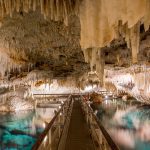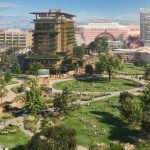
Eilish Vicencio-Heap
2026 will see the centennial of historic Route 66, with special events happening throughout the year — and throughout the route. With many opportunities to celebrate the anniversary, the American Indian Alaska Native Tourism Association (AIANTA) is encouraging travellers to take the opportunity to engage with Indigenous tourism along the way.
To promote responsible cultural tourism, AIANTA produced the guidebook American Indians & Route 66 in consultation with tribes whose nations are near the route. The guide “seeks to inform and to point the way to genuine cultural experiences along Route 66.” With Indigenous tribes often misrepresented as monolithic, it states that “the road can help break down these stereotypes as tribes actively share their distinct cultures and histories.”
The guidebook can be downloaded for free at nativeamerica.travel. Travel Courier experienced some of what awaits mindful travellers visiting Native American homelands during a recent FAM hosted by AIANTA in partnership with Brand USA.
The Hualapai Tribe and Grand Canyon West
With the Grand Canyon at the top of the to-do list for many people road tripping Route 66, Grand Canyon West is a good place to start. The Grand Canyon Resort Corporation, owned and operated by the Hualapai Tribe, provides visitors access to Grand Canyon West at the Skywalk cantilever bridge, viewpoints like Eagle Point and Guano Point, and via zipline or helicopter tours.
Two lodging options in addition to RV parking are also available. The Cabins at Grand Canyon West offer expansive views and are the perfect spot to watch sunrises, sunsets and clear night skies in a serene area. Cabins sleep up to six and bookings include two general admission tickets to Grand Canyon West. Travellers can also stay at Hualapai Lodge in Peach Springs, Arizona to enjoy spacious suites, the onsite Diamond Creek restaurant and access to whitewater rafting, hiking, fishing and more.
Navajo (Diné) Nation
Just before turning off Route 66 to enter Navajo Nation, be sure to stop by Walnut Canyon National Monument. Guests can hike into Walnut Canyon to get up close to ancient dwellings of the Sinagua people. Multiple lookouts also make the canyon viewable from above near the visitor center.
Once in Navajo Nation, travellers will find the Little Colorado River Gorge lookout and trails accessible through Little Colorado River Navajo Tribal Park. With mountains on one side and plains on the other, this segment of the Grand Canyon is dramatic yet peaceful and not to be missed.
Also in Navajo Nation is Dinosaur Tracks, an area where 200 million year-old dinosaur footprints and fossils lie. Visitors can walk through the area on their own, but Navajo guides are onsite to provide context on the significance of the area, how the fossils were formed and the stories they reveal.
Window Rock, Arizona, the capital of Navajo Nation, is home to Window Rock Tribal Veterans Park, which pays homage to Navajo who served in the military as soldiers and Code Talkers. The eponymous Window Rock formation is also viewable at this site. Nearby are the Navajo Nation Museum and Library, where visitors can learn about Navajo art, history and culture through artifacts, photographs, installations and more. A visit to the Navajo Nation Zoo, the only zoo in the U.S. owned and operated by a Native American tribe, also highlights the importance of wildlife to the Navajo people.
“One of our biggest focuses is on cultural tourism and having people experience the Navajo way of life,” says Shaunya Manus, senior economic development specialist at Navajo Nation Division of Economic Development. “It is important that visitors make sure the land is not disrupted. The dos and don’ts are on our website, discovernavajo.com.”
Hopi: The People of Peace
The Hopi reservation, located near Route 66 in Arizona and surrounded by Navajo Nation, is accessible with private vehicles, but many areas are not able to be visited without a Hopi guide.
Experience Hopi guides take visitors through areas like Coalmine Canyon and the ancient petroglyphs at Dawa Park, as well as to stops on the Hopi Arts Trail. The Trail extends the opportunity to meet local artisans such as basketweavers, silversmiths and potters, visit their workshops and purchase their goods directly.
Experience Hopi offers standard or customizable tours which depart from the lobby of one of the newest hotels on Hopi Tribal Land, Moenkopi Legacy Inn & Suites. The hotel, located near the Grand Canyon, Monument Valley, Antelope Canyon and other popular sites, offers complimentary breakfast, 100 guest rooms and 3,096 square feet of conference space.
Says DeAnnethea Long, director of operations at Moenkopi Developers Corporation, “Canada has been really good to us. We see a lot of visitors who are doing the Grand Circle road trip or coming from Las Vegas.”
Albuquerque and New Mexico’s 19 Pueblos
For those who continue along Route 66 to New Mexico and are in the mood for adventure, the 4.46-kilometre Sandia Peak Aerial Tramway takes guests up to 10,378 feet in elevation. Take in the sweeping views above Albuquerque at the lookout point or hiking trails, and enjoy fine or casual dining atop the mountain at TEN 3.
While much of Route 66 passes through rural areas, roadtrippers looking for a more urban experience can visit downtown Albuquerque for the route’s longest urban stretch. Ongoing preservation of Route 66’s history is evident at revitalized establishments including the El Vado Motel, Imperial Inn, Ex Novo Brewing Company, 66 Diner and M’Tucci’s Bar Roma, which feature historic Route 66 signage, gas pumps, garage doors and other fixtures in an upbeat urban centre.
Stop by the Indian Pueblo Cultural Center (IPCC) to see the permanent exhibit showcasing the resilience and living culture of New Mexico’s 19 Pueblos, plus signature events throughout the year like Spring Arts Market, American Indian Week and the Cultural Dance Program. Established in 1976, next year will be the Center’s 50th anniversary of reclaiming the former site of the Albuquerque Indian School and championing Pueblo culture. The IPCC also provides a not-to-be-missed culinary experience at the Indian Pueblo Kitchen.
And for roadtrippers craving a taste of home, TownePlace Suites by Marriott Albuquerque Old Town offers suites with full kitchens. Located across the street from the Indian Pueblo Cultural Center, it’s a prime jumping-off point for discovering Albuquerque and surrounding areas.
To learn more about Native American tourism, visit aianta.org.
Photos of Albuquerque courtesy of New Mexico Tourism Department and Kristy Graybill.

















